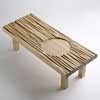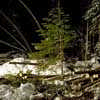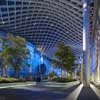Design for a Living World Exhibition, Smithsonian’s Cooper-Hewitt, US Buildings, Projects News
Design for a Living World Exhibition
Exhibition at Smithsonian’s Cooper-Hewitt, National Design Museum, USA
May 1, 2009
Design for a Living World Exhibition 2009
11 May 2009
Featuring:
Yves Béhar
Stephen Burks
Hella Jongerius
Maya Lin
Christien Meindertsma
Abbott Miller
Isaac Mizrahi
Ted Muehling
Kate Spade
Ezri Tarazi
We’ve focused on Maya Lin, a New York architect:
Maya Lin
Architect, artist and furniture designer Maya Lin in her New York studio, examining different types of FSC-certified wood from The Nature Conservancy’s property in northern Maine.

photo : Mackenzie Stroh
The wood used for Lin’s bench came from FSC-certified land managed by The Nature Conservancy.

photo : Dan Whipps
Red spruce is sustainably harvested during the winter on land managed by The Nature Conservancy in upper Maine.

photo : Ami Vitale
The Nature Conservancy and the Smithsonian’s Cooper-Hewitt, National Design Museum Present “Design for a Living World”
This spring, The Nature Conservancy and the Smithsonian’s Cooper-Hewitt, National Design Museum will present “Design for a Living World,” a traveling exhibition featuring objects created by leading designers and made from sustainable, natural materials. The exhibition will premiere at Cooper-Hewitt, National Design Museum on May 14 and continue through Jan. 4, 2010.
The Nature Conservancy collaborated with prominent designers from the worlds of fashion, industrial and furniture design, and each designer focused on a natural material from a specific place where the Conservancy works. The locations ranged from iconic American landscapes, such as the sweeping grasslands of Idaho, to such exotic places as the southwest coast of Australia and the forests of China’s Yunnan Province.
The designs explore the transformation of organic items—wood, plants, wool— into beautiful and useful objects. By choosing sustainable materials that support, rather than deplete, endangered places, designers can help reshape our materials economy and advance a global conservation ethic. Through this process, the exhibition reveals fascinating stories about regeneration, natural places and the human connection to the Earth’s lands and waters.
The exhibition features designs by Yves Béhar, Stephen Burks, Hella Jongerius, Maya Lin, Christien Meindertsma, Isaac Mizrahi, Abbott Miller, Ted Muehling, Kate Spade and Ezri Tarazi.
• Béhar worked with a women’s chocolate cooperative in Costa Rica to develop packaging for the raw cocoa they use to make a traditional hot drink and a grating tool that evokes the sensual nature of chocolate, delivering an intense experience through taste, form and narrative.
• Burks traveled to Australia’s Gondwana Link to design the “Totem”—a tool made from reclaimed native jamwood that the local Noongar people can use to make and package a line of organic herband sandalwood-based cosmetics that they are developing for export. May 1, 2009 SI-462-2008 2
• Dutch designer Jongerius traveled to the Yucatan Peninsula to observe traditional chicle latex harvesting and explore the possibilities of chicle beyond its use in chewing gum production, resulting in more than 20 embellished vessels and plates.
• Using wood harvested from a Forest Stewardship Council-certified Nature Conservancy property in Maine, Lin crafted a striking piece of furniture that highlights the beauty of an individual tree.
• Meindertsma used wool sourced from a sustainable sheep ranch in Idaho to create a large-scale knit rug—a “flock” of smaller components, each one made from 3.5 pounds of wool, the yield of a single sheep.
• Famed fashion designer Mizrahi turned Alaskan salmon skin—typically a waste product of the salmon industry—into a dress that references the scales of the fish from which it was made.
• Using FSC-certified plywood from Bolivia, Miller designed a chair whose components can be shipped flat and dry-assembled with a rubber mallet. The chair design highlights the beauty of Bolivian wood, while also yielding three chairs per sheet of plywood, with a minimal amount of waste.
• Acclaimed jewelry designer Muehling transformed Micronesian vegetable ivory and ocean-harvested black and keishi pearls into a series of bracelets, necklaces and other items, spotlighting the beauty of these natural materials.
• Paulina Reyes, for kate spade new york, traveled to Bolivia’s forests to work with local craftspeople to design a series of handbags made of sustainable wood, cotton and jipijapa, a fiber made of palm leaves.
• Industrial designer Tarazi designed a series of adjustable components that connect to mature bamboo stalks from China’s Yunnan Province, creating a domestic forest that supports a range of living arrangements.
“Our goal with the exhibition is to connect audiences to the natural world by exploring the story of place through innovative design,” said Mark Tercek, president and chief executive of The Nature Conservancy. “‘Design for a Living World’ challenges us to think about the products we use—where they come from, how they are made and what the impacts are on our planet and on local communities.”
“‘Design for a Living World’ offers a captivating look into the life cycle of materials and the power of conservation and design,” said Paul Warwick Thompson, director of Cooper-Hewitt. “Cooper-Hewitt is delighted to partner with The Nature Conservancy in raising awareness about material conservation and sustainable design solutions.”
“This exhibition opens an important conversation between conservationists and designers about the potential and legacy of natural materials,” said Abbott Miller, co-curator of the exhibition. “By choosing sustainable materials, designers contribute to the advancement of a global conservation ethic that can foster consumer awareness.”
“Design for a Living World” is co-curated by Miller and Ellen Lupton. Miller, a partner in the New York office of Pentagram, is recognized for his innovative installations for the National Building Museum, the Rock and Roll Hall of Fame, the Freud Museum in Vienna, Austria and the permanent exhibitions at the Harley-Davidson Museum. Lupton is curator of contemporary design at Cooper-Hewitt and is the author of many books on design.
The exhibition and book will also feature specially commissioned photographs from award-winning photojournalist Ami Vitale, whose work has appeared in The New York Times, Newsweek and National Geographic. The structures used to display the exhibition will include Forest Stewardship Council-certified plywood from community forests in Bolivia. A catalog, published by Cooper-Hewitt, will be released in conjunction with the exhibition.
Design for a Living World Exhibition – Background
“Design for a Living World” was developed by The Nature Conservancy.
The exhibition’s presentation at Cooper-Hewitt is made possible in part by Enid and Lester Morse.
Additional support is provided by the Adobe Foundation, Esme Usdan, Alice Gottesman and Laurence Zuckerman, The Consulate-General of The Netherlands in New York as part of its NY400 Celebrations, and Susan and David Rockefeller. Media sponsorship is provided by New York magazine and WNYC.
About The Nature Conservancy
The Nature Conservancy is a leading conservation organization working around the world to protect ecologically important lands and waters for nature and people. To date, the Conservancy and its more than 1 million members have been responsible for the protection of more than 18 million acres in the United States and have helped preserve more than 117 million acres in Latin America, the Caribbean, Asia and the Pacific.
About Cooper-Hewitt, National Design Museum, Smithsonian Institution
Cooper-Hewitt, National Design Museum is the only museum in the nation devoted exclusively to historic and contemporary design. Founded in 1897 by Amy, Eleanor, and Sarah Hewitt—granddaughters of industrialist Peter Cooper—as part of the Cooper Union for the Advancement of Science and Art, the museum has been a branch of the Smithsonian since 1967. The museum presents compelling perspectives on the impact of design on daily life through active educational programs, exhibitions and publications.
Location: New York City, USA
New York City Architecture
Contemporary New York Buildings
Manhattan Architectural Designs – chronological list
New York City Architecture Tours by e-architect
Cooper-Hewitt NYC Architecture Designs
Cooper-Hewitt National Design Awards
Contemporary Muslim Fashions Exhibition, NYC
American Architecture
American Institute of Architects Gold Medal
Exhibitions – chronological list
Smithsonian Museum – Robert and Arlene Kogod Courtyard
Design: Foster & Partners

photo : Nigel Young / Foster + Partners
Smithsonian Institute
Comments / photos for the Cooper-Hewitt Design for a Living World Exhibition page welcome
